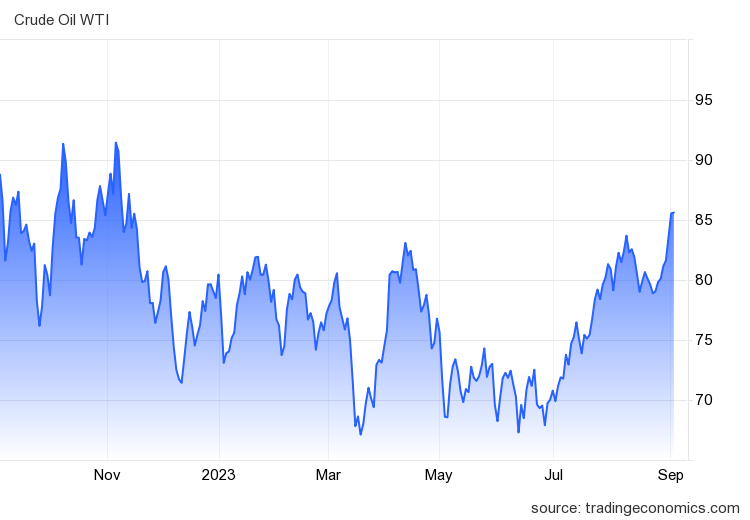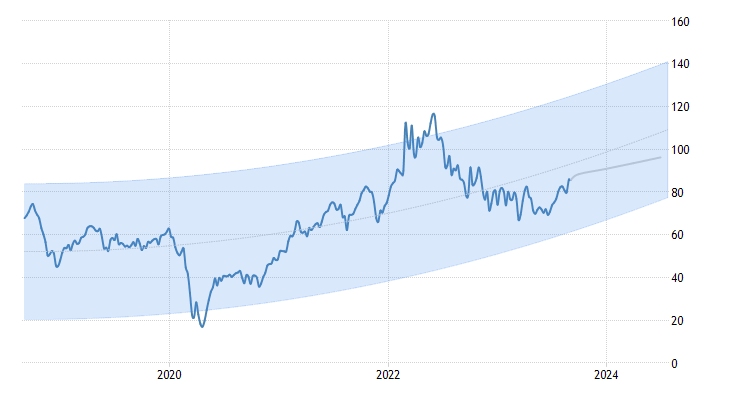Introduction
In the ever-evolving landscape of the global energy market, one signal stands out amidst the cacophony of economic indicators and geopolitical developments – the WTI crude oil price. As of Monday, WTI crude surged above the $85 per barrel mark, an ascent not witnessed in over nine months. This surge is intrinsically tied to the anticipation that OPEC+ leaders will prolong their measures to maintain a stranglehold on oil supplies. Key players in this scenario, including Russia and Saudi Arabia, are poised to continue their export cuts, exerting significant influence on the global energy equilibrium. Simultaneously, a surprising expansion in Chinese manufacturing activity is kindling optimism regarding the world’s largest oil importer’s economic health. Furthermore, indications that the U.S. economy may be cooling have ignited speculation that the Federal Reserve could halt its rate hikes, thereby fostering a buoyant market sentiment. Crude oil signals
Market Dynamics and the Crude Oil Signals
The surge in WTI crude oil, now well above $85 per barrel, is more than just a numerical milestone. It serves as a pulsating signal, reverberating across the global economy, and is a testament to the intricate dance between supply, demand, and geopolitical factors. The “crude oil signal” is a term that encapsulates this phenomenon, representing the vital cues that investors and policymakers need to heed.
Transitioning from a prolonged period of volatility, this signal emerges from a delicate equilibrium. The anticipation of OPEC+ leaders extending their efforts to constrict oil supplies is a pivotal factor in this equation. Russian Deputy Prime Minister Alexander Novak’s recent announcement of Russia’s accord with OPEC partners on export cut parameters adds depth to this narrative. Additionally, Saudi Arabia’s commitment to maintaining its voluntary 1 million barrels per day output cut into October bolsters the signal’s resonance. As we delve deeper into the dynamics of crude oil, it becomes apparent that the “crude oil signal” is not just a number; it’s a multifaceted indicator of global economic health.

Chinese Manufacturing Expansion: Catalyst for Optimism
China, the world’s largest oil importer, plays a significant role in shaping the “crude oil signal.” Recent reports indicate a surprising surge in Chinese manufacturing activity, as revealed by a private survey. This unexpected development has added a layer of optimism to the oil market’s complexity.
The expansion in Chinese manufacturing activity is a key facet of the “crude oil signal” that cannot be overlooked. It underscores the interconnectedness of the global economy and the oil market. China’s manufacturing boom signifies increased demand for raw materials, including oil, as they are essential for production processes. As China’s manufacturing sector thrives, it amplifies the call for crude oil, propelling prices upward. This not only strengthens the “crude oil signal” but also provides investors with a clear directive – keep a vigilant eye on China’s economic health.
U.S. Economic Cooling: Implications for the Crude Oil Signals
While China’s manufacturing expansion bolsters the “crude oil signal” from the demand side, the United States presents a contrasting narrative. Signs that the U.S. economy may be cooling have emerged as a factor that influences market sentiment and the “crude oil signal.”
The relationship between the U.S. economy and the “crude oil signal” is nuanced. A cooling U.S. economy can have divergent effects on the oil market. On one hand, it can be interpreted as a sign of reduced demand, potentially exerting downward pressure on oil prices. On the other hand, a slowdown in the U.S. economy can also signal a potential shift in the Federal Reserve’s monetary policy. If the Federal Reserve decides to halt its rate hikes due to economic concerns, it could lead to a weaker U.S. dollar, which often results in higher oil prices. Thus, the U.S. economic cooling factor adds layers of complexity to the “crude oil signal,” making it a vital consideration for investors and policymakers alike.

Navigating the “Crude Oil Signals” for Investment
For investors seeking to navigate the intricate web of the “crude oil signal,” a nuanced approach is essential. The signal encapsulates a multitude of factors, including supply dynamics, demand fluctuations, and geopolitical influences. Here are some key insights to consider:
- Diversification: Given the inherent volatility of the oil market, diversifying your investment portfolio is paramount. While oil can be a lucrative asset, its price fluctuations can be severe. Diversification across various asset classes can help mitigate risks associated with oil price volatility.
- Stay Informed: Keeping a close watch on geopolitical developments, OPEC+ decisions, and economic indicators is crucial. The “crude oil signal” is dynamic and can change rapidly in response to global events. Staying informed allows investors to make timely and informed decisions.
- Risk Management: Implementing risk management strategies is essential when investing in the oil market. Options, futures contracts, and other derivatives can be utilized to hedge against adverse price movements.
- Long-Term Perspective: While short-term trading in the oil market can be profitable, a long-term perspective can provide stability. Oil prices tend to exhibit cyclical patterns, and a patient approach can yield favorable results over time.
- Consult with Experts: Seeking advice from financial experts and professionals with a deep understanding of the oil market can be invaluable. They can provide tailored guidance based on your investment goals and risk tolerance.
Conclusion
In the realm of global finance, the “crude oil signal” stands as a beacon of insight, guiding investors through the tumultuous waters of the oil market. Its significance cannot be overstated, as it encapsulates a multitude of factors that shape the world’s economic landscape. From the anticipation of OPEC+ decisions to the expansion of Chinese manufacturing and the nuances of the U.S. economy, the “crude oil signal” is a dynamic force that demands attention.
As investors, policymakers, and market observers, it is our responsibility to decipher this signal with precision and wisdom. By understanding the intricate interplay of supply, demand, and geopolitics, we can harness the power of the “crude oil signal” to make informed investment decisions and navigate the ever-evolving world of finance. In a world where uncertainty is the only constant, the “crude oil signal” remains a steadfast guide on our journey through the global economy.






I will immediately grab your rss feed as I can not to find your e-mail subscription hyperlink or e-newsletter service. Do you’ve any? Please allow me understand so that I could subscribe. Thanks.
I am always invstigating online for articles that can aid me. Thx!